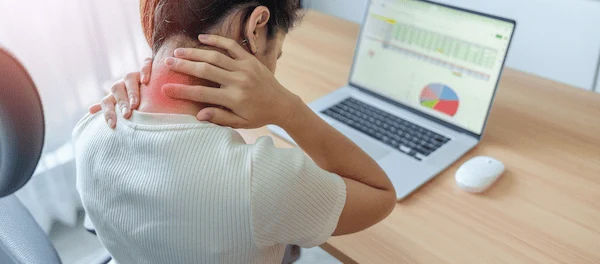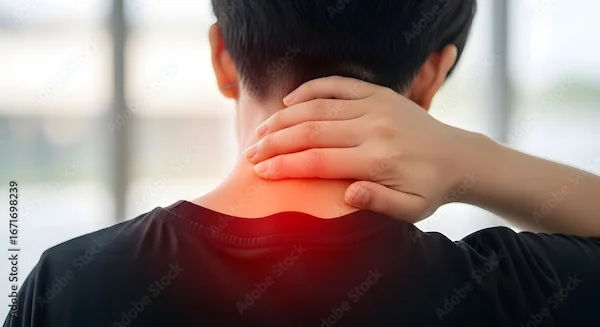How To Reduce Cervical Pain?
Reduce cervical pain effectively with proven techniques! Find out the best exercises, treatments, and habits for long-term relief.

Written by
Last updated on 3rd Jul, 2025
Cervical pain is a common condition that affects a large number of people who experience pain, stiffness, and discomfort in the cervical spine (neck area). It can be mild or severe, primarily affecting the ligaments, muscles, and bones of the neck. In certain cases, it can also radiate to arms, upper back, and shoulders. It is caused mainly due to poor posture, muscle strain, trauma, injury or underlying medical conditions and may be chronic, acute, or radicular. However, it may lead to cervical myelopathy in severe cases. The common risk factors for this include increasing age, occupation, smoking, obesity, sedentary lifestyle, and genetic reasons.
Symptoms And Diagnosis
Cervical pain symptoms often include limited head movement, sleep issues, balance problems, and worsening pain with prolonged head positions. Muscle tightness, numbness, spasms, tingling, and weakness in the limbs might occur due to nausea and dizziness.
To check the severity of the condition, healthcare providers follow some diagnostic methods and tests. They will test the amount of tenderness, muscle weakness and numbness. The doctors will also gauge the head movement ability - forward, backwards and side to side. Some imaging tests that they generally prescribe are -
X-rays
CT Scan
MRIs
Electromyography
Blood Tests
Get Your Health Checked
Non-Surgical Treatments
A non-surgical approach is always preferred for the treatment of cervical pain. Here, complications and risks are low, recovery is fast and is less invasive than surgeries. Most of the cervical pain symptoms can be managed with conservative methods like physical therapy and medications. Some popular physical therapy techniques are -
Neck stretches like chin tucks, lateral neck flexions and neck rotations.
Shoulder exercises like shoulder blade squeeze and shoulder rolls.
Posture correction and awareness exercises.
Manual therapy like cervical mobilisations and soft tissue massage.
Heat and ice therapy.
Mechanical cervical tractions.
If the pain is severe, a doctor may prescribe strong medications. However, in case of mild or moderate pain, the commonly used pain management medications are -
Nonsteroidal anti-inflammatory drugs (NSAIDs) like ibuprofen or naproxen sodium
Acetaminophen
Lifestyle Changes And Home Remedies
Modern lifestyles strain the cervical spine, worsening pain. Preventive measures like posture correction, mainly forward head posture, help reduce stress, discomfort, and tension in the neck. Simple routine changes and home remedies are essential for relief.
Some exercises to get rid of cervical pain are -
Tilted forward flexion
Deep stretching
Resistance presses
Towel pull
Shoulder blade squeezes
Neck rotation
Chin tucks
Alternative Treatments
Often, people seek alternative treatments like acupuncture, chiropractic care or use herbal supplements to treat cervical pain. These give relief from pain and stiffness with lesser or almost negligible side effects.
1. Acupuncture
Acupuncture treatment originates from China. This process involves inserting the fine needles at specific acupoints to influence mental and physical functions. For cervical pain, neck, back, or shoulder needles stimulate endorphin release, easing pain and numbness. This is effective for cervical spondylosis, herniated discs, and muscle strains, offering long-term relief.
2. Chiropractic Care
Cervical pain can happen due to misalignments or dysfunction in the cervical spine. This can be treated with chiropractic care, where spinal misalignment is corrected through controlled pressure by a licensed chiropractor. This helps to reduce the pain and discomfort significantly without any drug or surgery. Chiropractors often suggest specific exercises that, if practised regularly, give long-term relief.
3. Herbal Supplements
Herbal supplements are also used to treat cervical pain naturally. Some examples are -
Ashwagandha
Guggulu
Turmeric
Ginger
Essential oils like lavender or peppermint oil
Role Of Nutrition And Diet
A balanced diet that is particularly rich in anti-inflammatory foods, high in calcium, vitamin D and omega-3 fatty acids reduces cervical pain. It makes the bones healthy, helps the muscles usually function, and minimises inflammation, thus allowing the cervical spine to heal.
Some anti-inflammatory foods that must be included in the diet are -
Fatty fish like salmon, tuna, sardines, etc.
Walnuts.
Almonds
Leafy greens like spinach
Watermelon
Pomegranate
Berries
The cervical discs are mostly composed of water. So, adequate water intake is necessary to maintain healthy discs, depending on the climate of one’s residing place, body size and exercising habits. Proper hydration assures a good and flexible neck with sufficient shock-absorbing capability and normal blood circulation. On the contrary, dehydration results in irritated and compressed discs, increasing the pain and discomfort.
Prevention Strategies
Adopting prevention strategies is essential to reduce the risk of developing cervical pain or exacerbation of the existing trouble. Some necessary ergonomic adjustments that should be made are -
Adjustment in workstation setup - The computer setup should be such that the top third of the screen is at eye level. This reduces neck strain. Also, the chair used must have good lumbar support, and the keyboard and mouse should be close to the body.
Usage technique of mobile devices - To avoid looking down for a long time, the mobile phones should be held at eye level. Increasing the text size also helps.
Awareness of posture - Sitting and standing with a straight back while keeping the shoulders relaxed is a good habit.
Taking breaks from movements - To avoid staying in the same position for a long time, taking breaks and walking around is a healthy habit.
Some stress management techniques to reduce cervical pain are -
Deep breathing exercises
Yoga
Meditation
Regular physical activity
Maintaining good posture
Quality sleep with proper neck support
When to Seek Medical Attention?
At times, the cervical pain becomes severe, indicating a serious condition. This is when medical attention becomes necessary. However, recognising the worsening symptoms of cervical pain is crucial to understand when to take the help of a doctor. Some such symptoms are -
The pain becomes intense, sharp, stabbing, and unbearable, radiating to the shoulders, arms or hands, accompanied by numbness and tingling.
The pain is persistent, worsening and lasting longer than a few weeks.
Weakness in arms, hands and fingers, along with neck pain.
Neck pain is associated with lightheadedness, dizziness and an off-balance feeling.
The neck becomes extremely stiff and is associated with a sudden loss of movement.
Experiencing worsening cervical pain after a trauma or injury.
Surgery becomes an option to treat cervical pain when conservative and non-surgical treatment fail. For example, if the MRI scans show significant disc herniation, spinal stenosis or bone spurs that are compressing the spinal cord or nerve root, then surgery becomes necessary.
Recent Advances In Treatment
The recent advances in cervical pain treatment mainly emphasise conservative and non-surgical approaches. However, some examples of minimally invasive procedures are -
Radiofrequency ablation
Cervical injections like nerve blocks
Anterior cervical discectomy and fusion (ACDF)
Cervical endoscopic spine surgery
Spinal cord stimulation
Recent innovations in cervical pain-relief technology are -
Advanced spinal cord stimulation (SCS) with waveform programming and improved lead designs.
Platelet-rich plasma (PRP) injections.
Transcutaneous electrical nerve stimulation (TENS).
Virtual reality (VR) therapy.
Targeted corticosteroid injections.
Conclusion
Cervical pain is a condition usually curable with self-care, as it is mainly caused due to poor posture or muscle strain. However, if there is any underlying seriousness, like cervical spondylosis or disc herniation, it may primarily affect one’s daily life. The key strategies that may help to prevent the condition are regular exercise, maintaining good posture and managing stress. If the pain becomes persistent and worsens, early intervention through a healthcare evaluation becomes necessary. Physical therapy, chiropractic care and medications will provide relief. Neglecting the symptoms can lead to more trouble and long-term disability. So, it is wise to consult a doctor promptly rather than suffer for a lifetime.
Consult Top Gynaecologists
Consult Top Gynaecologists

Dr. Revathi S Rajan
Obstetrician and Gynaecologist
24 Years • MBBS, DGO, DNB.FFMM
Bengaluru
Apollo Clinic, JP nagar, Bengaluru

Dr. Rupam Manna
Radiation Specialist Oncologist
4 Years • MBBS MD(RADIO THERAPY)
Barasat
Diab-Eat-Ease, Barasat

Dr. Sreeparna Roy
Obstetrician and Gynaecologist
8 Years • MBBS , MS (OBSTETRICS & GYNAECOLOGY), Fellowship in Infertility, Endoscopy & Ultrasonography), Fellowship in Laparoscopy & Hysteroscopy,DRM
Kolkata
Dr Utsa Basu Clinic, Kolkata
Dr. Navin Srinivasan
Gynaecological Oncologist
9 Years • MBBS, MS DNB(OBS-GYNAE), MCH (GYNAE ONCOLOGY)
Bengaluru
Apollo Clinic Mahadevapura, Bengaluru

Dr. Swati Shah
Surgical Oncologist
15 Years • DNB Surgical Oncology, certified Robotic Cancer Surgeon
Ahmedabad
Apollo Hospitals Gandhinagar, Ahmedabad
(25+ Patients)




